Ukuleles and guitars, though both stringed instruments, have several differences. Ukuleles generally have 4 nylon strings, a smaller body, a thinner fretboard, and a bright, trebly sound. Guitars usually have 6 steel strings, a much larger body, a thick fretboard, and a deep, full-bodied tone.
Maybe you walk into a store, and you spot a ukulele and a guitar. What do you get? If you’re about to pick up one of these instruments and you’re confused about whether to get a ukulele vs guitar, we’re here to help.
With this quick guide, you’ll be able to compare the ukulele vs. the guitar in detail, and we’ll give our advice on which one is best suited for you, so you can jam to your favorite songs!
Post Contents
What Are the Differences Between a Guitar and a Ukulele?
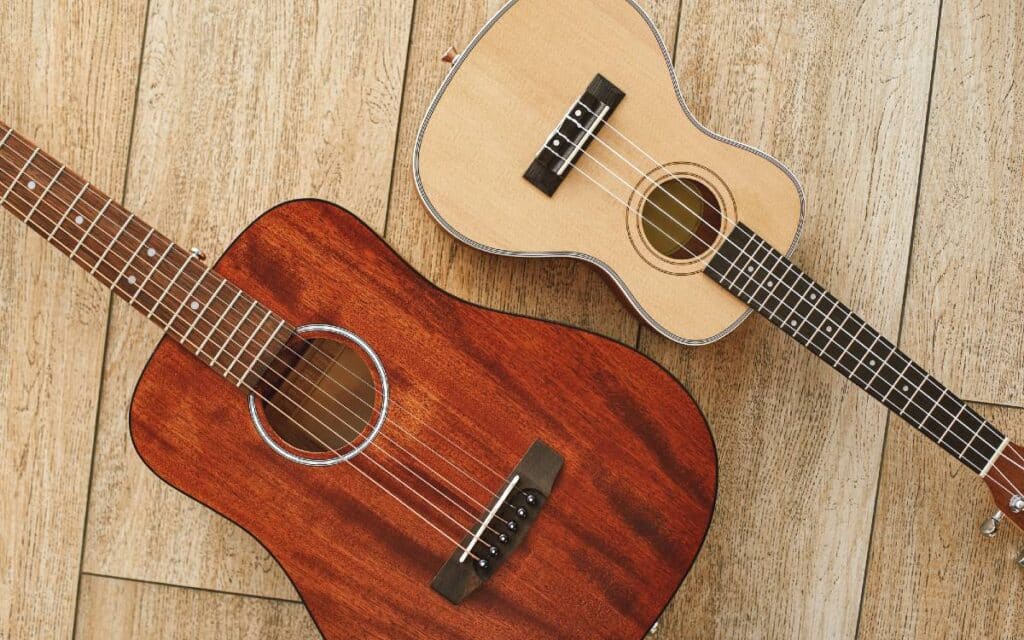
The ukulele originates from Hawaii and is a descendant of traditional Portuguese instruments like the cavaquinho, rajão, and machete de braga. It was created in the 19th century and has become super popular in modern music.
A guitar is a plucked string instrument. The modern Spanish guitar comes in many shapes and sizes, but generally consists of six strings (or even 12!). It originates from the Latin word cithara, which was an ancient Greek instrument.
Here’s a rundown of all the differences between a guitar and a ukulele.
Types
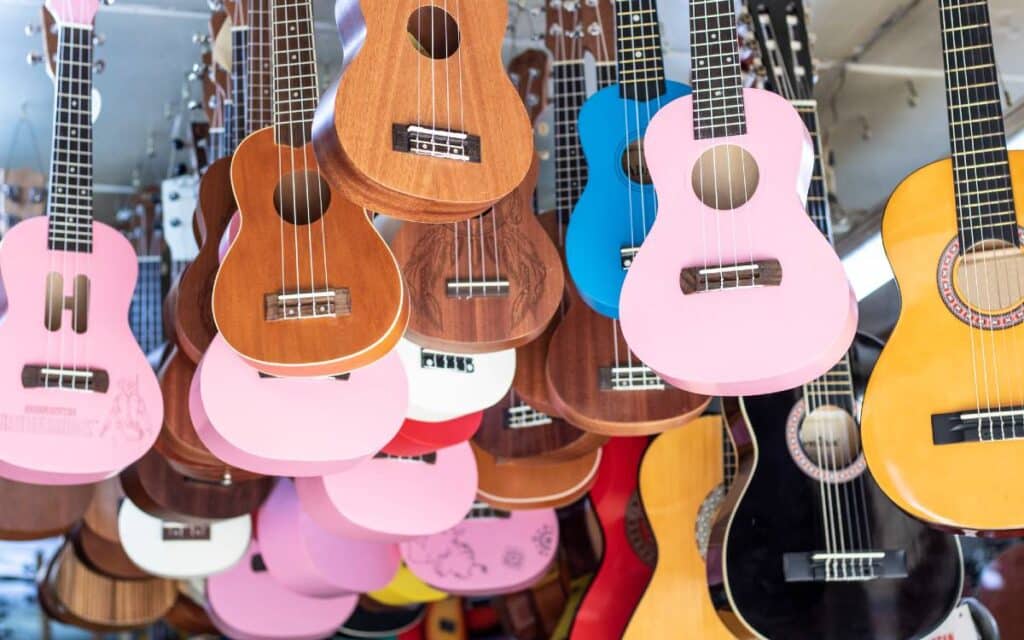
The four common types of ukuleles are soprano, concert, tenor, and baritone. Each one has slight differences in its scale length, tuning, and overall sound. Since sopranos are the most common type, we’ll compare that.
There are various types of guitars, but the common ones include acoustic, classical, electric, and bass. Each one has a different construction and a unique sound. While that can make this comparison difficult, we’ll stick to an acoustic guitar as it’s the most popular (there are also many different types of acoustic guitars).
So for simplicity, we’ll be comparing a soprano ukulele vs. an acoustic guitar, but we’ll also discuss some of the other types in general so that you get a clear picture.
Size and Body Shape
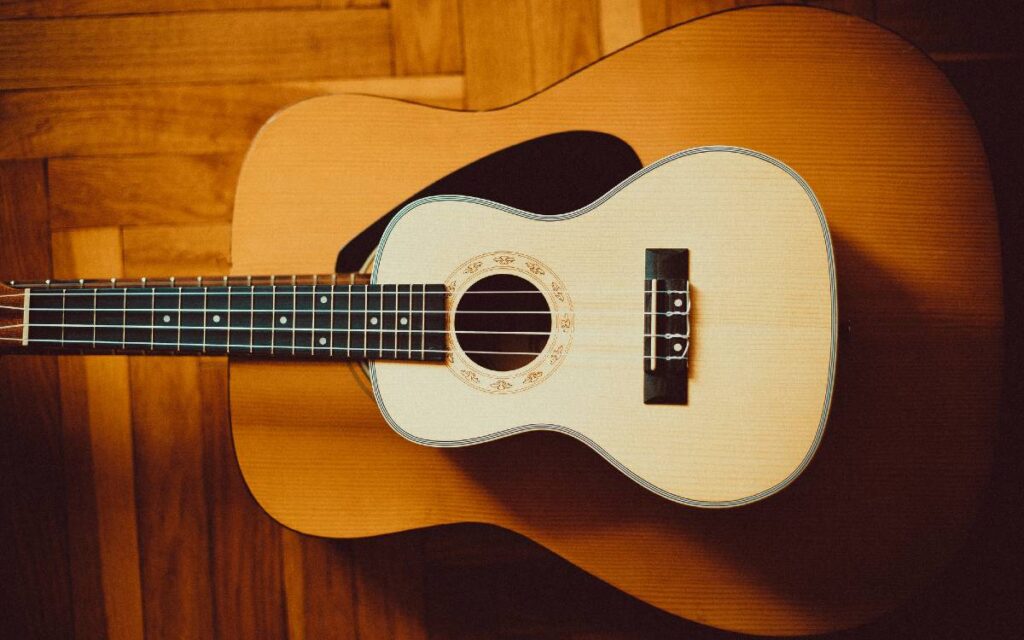
The size and body shape of a ukulele are much smaller than a guitar, so musicians can easily carry it. However, this makes changing chords much harder for some people when playing the ukulele. The main reason for this is that the strings are much closer together on a ukulele.
The size of a guitar is about 40-60% bigger than a ukulele so it can produce louder music. This also allows for easier chord changes, and there’s more room for movement.
The sizes for the various ukulele types also differ, with sopranos being the smallest and tenor and baritone ukuleles being the biggest. Guitars also come in various body shapes – jumbo, super jumbo, parlor (smallest), dreadnought (largest), and travel guitars.
All these have variations in tone and playability. For this, we recommend trying out a few different models yourself and seeing which one is comfortable for you.
A ukulele is likely a better choice if you want something very portable – easy to pop in the trunk of your car. A guitar is not as easy to carry, but it has a louder sound and more versatility. Both are perfect for campfires!
Materials And Construction

Both the ukulele and guitar are made of wood, but the main difference is that the ukulele has four nylon strings while the guitar has six metal strings.
The material used for both instruments affects their sound quality. For example, the most common woods for ukuleles include mahogany, koa, maple, and rosewood. Guitars are built from an even larger variety of woods, but common ones include spruce, cedar, alder, ash, basswood, mahogany, walnut, and ebony.
Construction for both ukuleles and guitars is very similar. They have similar anatomies. The parts of a guitar are very similar to the parts of a ukulele. Many guitar luthiers are also known to make ukuleles, since the process is transferable, but with some minor differences.
Scale Length

The scale length of a stringed instrument is the distance between the nut and the saddle – it effectively determines the pitch and frequency range for the guitar or ukulele.
A typical soprano ukulele has a scale length of 13 inches, and for a concert, tenor, and baritone it’s 15”, 17”, 19” respectively. For most guitars, it ranges from 24.75” to 25.5”, with an average of 25”. But basses have an extended scale length so they can handle lower notes easily.
The length of the strings (a factor of scale length) is another important difference between a ukulele and a guitar, as well as their string tension. Guitars have a longer scale length, so the guitar string tension is higher than the ukulele string tension. The scale length of one type of guitar can vary slightly depending on how it was made. The scale length for both instruments is very important as it has an effect on the overall sound.
The essential thing to remember is: a shorter scale length means higher pitched notes. So if you want the sweet, chirpy Hawaiian sound, a soprano ukulele fits the bill. A baritone ukulele is perfect if you want a bass-heavy sound. The longer scale length of an acoustic guitar adds to the full-bodied, rich tone with more harmonics.
Strings and Tension

The strings are the core of any guitar or ukulele, and they have one of the biggest impacts on the sound. A ukulele generally has four nylon strings, while acoustic guitars have six steel strings of various types (80/20 bronze and phosphor bronze are the most common.
But you can find ukulele variants with 8 strings, and even steel strings. Classical guitars also use nylon strings, while electric guitars typically use nickel strings — the string material, gauge, and tension all impact the sound.
The four nylon strings used by the ukulele are much thinner (lower gauge) than the six steel strings used by acoustic guitars. The tension of the guitar strings is much higher because of the longer scale length, so they produce a warmer sound. On the other hand, ukulele strings are low tension and produce a mellow sound.
Since strings are changeable, you can get different strings on whichever instrument you have and get a different tone from it. But you have to keep in mind the gauge and tension, as putting improperly balanced strings can bend or even break your neck. For this, we recommend consulting with your local shop or a luthier.
Sound and Tonal Quality
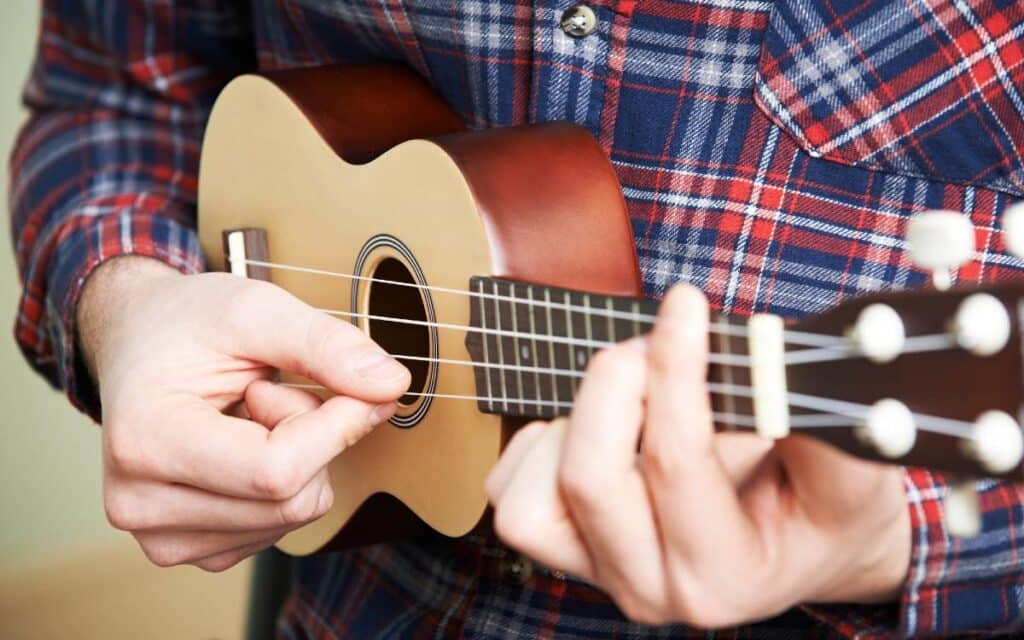
The most important thing in any instrument is its sound, and this is what the guitar and ukulele are widely different. Each ukulele type has its own distinct tonality – sopranos are the brightest, while baritones are the heaviest.
Guitar types all have different tones too – acoustics are bright and sharp, while classical guitars are mellow (much like a ukulele). Electrics have a wide variety of tones within themselves as it depends on the amplifier.
In general, a ukulele will be more mellow and smoother than a guitar, with lower sustain and volume. This also depends on your playing style – ukuleles are generally fingerpicked, but you could also play guitar with a plectrum (pick).
If you want a full-bodied tone that could fill a room, guitars are the way to go. But for sweet sounds that might just melt your heart, nothing beats a soprano ukulele!
Tuning
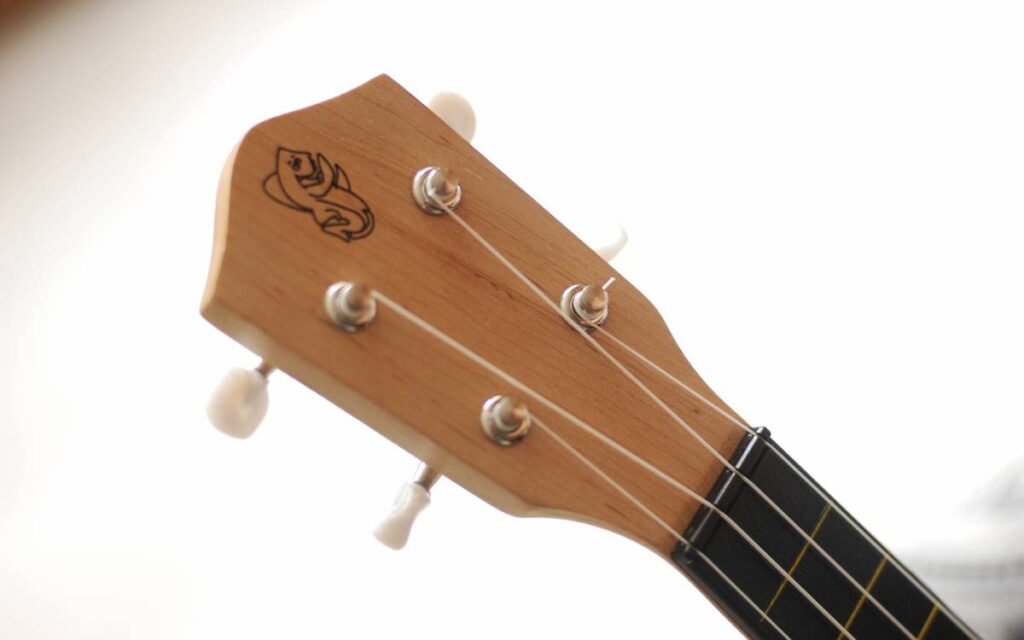
Both the ukulele and guitar are tuned by turning the pegs in order to tighten or loosen their strings. The standard ukulele tuning is usually G-C-E-A, but it’s possible to tune them to A-D-F#-B (one step higher) for a sweeter tone.
The tuning of a ukulele also depends on the type. For example, a baritone ukulele is tuned to D-G-B-E, the same as the last four strings of a guitar. This means that playing baritone ukulele chords is very similar to playing guitar chords. A soprano, concert, and tenor ukulele all have the same tuning (G-C-E-A), and use standard ukulele chords.
Guitars are generally tuned using standard tuning (E-A-D-G-B-e), but they have a much wider variety of tunings available. There’s also a bass ukulele, tuned to EADG using polyurethane strings, much like a bass guitar.
The general tuning variations include drop tunings, open tunings, and alternative tunings (which aren’t exactly diatonic). All this affects your instrument’s sound, playability, and what songs you can perform on it.
In general, the limited tunings of a ukulele prevent you from being able to play all the songs. Guitars, however, can be tuned across a wider range with no issues. You can consider using guitar capos to extend your range of songs and make difficult chords easier to play.
Price

Before you buy one, knowing the price difference between ukulele vs guitar is important. In general, ukuleles are cheaper than guitars because of the simpler woods, hardware, and compact design.
The cost of a good ukulele could be anywhere between $50 for a budget one to $500 for a premium model.
Guitars are typically a bit more expensive, with an average price between $100 to $1000, and even beyond that as you go into premium brands. On average, a standard guitar is usually a bit more expensive than a similar quality ukulele.
In any case, you will almost always find better quality at higher prices – better woods, better hardware, better craftsmanship, and better playability/sound. Experienced guitar players usually prefer going for more expensive instruments with time.
Custom-made and exotic ukuleles and guitars can cost even more, as these are difficult to find – you’ll need a skilled luthier. If your budget is tight, ukuleles are a great place to start.
And if by now you’ve decided you’ll get a ukulele, here’s a quick video to help you figure out what to look for:
Which One Should You Learn? – 4 Things To Consider When Starting Out
The most common question that beginners ask is which instrument they should learn first: a guitar or a ukulele?
Time and Effort
Beginners sometimes find it easier to start out on a ukulele because of its size and simplicity. Four strings are a great place to start learning chords, and ukulele chords are generally easier to play than guitar chords. It will also be easier to practice fundamental skills such as singing while playing (although you don’t have to sing to play the ukulele).
A guitar is often considered to be a more difficult instrument to play. Chords and strumming can often be more complicated, and there are additional skills like playing lead and improvisation. If your goal is to play guitar while singing your favorite songs, it can be a bit more difficult to get the coordination down.
But learning to play guitar also leads to more rewarding results. This is the main reason why beginners choose guitars – it keeps your options open and is more versatile.
The steeper learning curve for a guitar pays off in the long run as it can help you move on to other string instruments, including the ukulele, bass guitar, and others. But if you’re looking for an instrument that you can pick up within a few short weeks, the ukulele is the best choice.
So pick one depending on your schedule and availability.
Learning Materials And Courses

You should consider the availability of learning materials for both instruments. How do you plan to learn? A teacher? A professional music school? YouTube videos, or online lessons? Interactive learning apps?
Learning musical instruments has become a lot more accessible for everybody, but it can be a bit challenging to know what’s right for you. Some people can get it just right on their own, while others need more attention.
For ukulele vs guitar, it’s important to know that there are a lot more learning materials available for guitar. Music theory lessons on guitar, guitar song tutorials, tips and tricks for techniques, and guitar blogs are more readily found because the instrument has been around for so long.
Since ukuleles are newer, you may find it a bit harder to find good learning materials, especially ukulele song tutorials. But the internet is ever-growing, and more ukulele blogs and learning resources are coming up every week.
So you just have to find what you have access to (and can afford), and pick accordingly.
What Songs Do You Want To Play?

One of the main reasons why beginners decide to pick up a guitar is so that they can play songs from their favorite bands. The majority of popular songs are written for this type of instrument, making it an obvious choice if you have a passion for rock and pop music.
Ukuleles might be simpler to learn, but guitars produce a much richer and more versatile sound. This is the main reason why most songs are written for guitars because they can be used in a variety of different ways.
Guitar chord shapes also differ from ukulele chord shapes due to the differences in tuning. Both the guitar and ukulele can play all standard 24 chords.
Since most songs aren’t written for a ukulele, they have to be transcribed and arranged separately. Ukuleles can add a uniquely fun element to most songs, but as a beginner, you may not be able to play your favorite song if a ukulele tutorial isn’t available for it yet.
And if you’re serious about playing the song as faithfully as you can, then guitars are likely the better option. The intro to Guns n Rose’s Sweet Child ‘O’ Mine just isn’t going to sound the same on a ukulele. You need an electric guitar to emulate that legendary tone.
If you’re enthusiastic about playing songs by famous artists, then the best choice is to learn the guitar. However, the ukulele will still be a good alternative if you want to play tunes that are not written for this type of instrument. It lends a unique touch to most music.
Guitalele: The Best Of Both Worlds
If you really can’t decide between the ukulele and the guitar, then how about a hybrid of both? Enter the guitalele.
The guitalele also has Portuguese origins, and is a unique six-stringed instrument that combines elements from both a ukulele and a guitar. It is shaped and sized like a ukulele, so it’s easy to carry (it also works great as a travel guitar!).
The smaller size makes this perfect for kids and people with small hands, while the extended strings offer it the tonal range of a guitar. The nylon strings are commonly tuned to ADGCEa, five semitones higher than a normal acoustic guitar.
The Yamaha GL-1 Guitalele is likely the most popular guitalele model available right now. It’s affordable and the perfect companion for road trips and weekend getaways too. Here’s a demo and review of the GL-1:
So, if you really can’t decide between the ukulele vs guitar, the guitalele might be your best option. And the best thing is, your skills will easily be transferable to a ukulele or guitar in the future!
FAQs
Is it easier to play ukulele or guitar?
It’s easier to play the ukulele than the guitar, especially if you’re a beginner. This is because it has fewer strings and the chord shapes are easier than a guitar. Playing some of your favorite songs on a ukulele is quicker than on a guitar.
But at the same time, some people find the ukulele difficult because of the small body and lower string spacing, which can make your hands feel cramped at times.
Is it easy to learn ukulele If I know guitar?
Yes, it will be easy to learn the ukulele if you already know how to play the guitar because there is a similarity in terms of range and sound. The essential skills are transferable, including your music theory and chords, your finger dexterity, and of course, your sense of rhythm. All that makes it easy to learn ukulele if you know guitar. You’ll be able to pick up new songs much faster.
Can you learn ukulele and guitar at the same time?
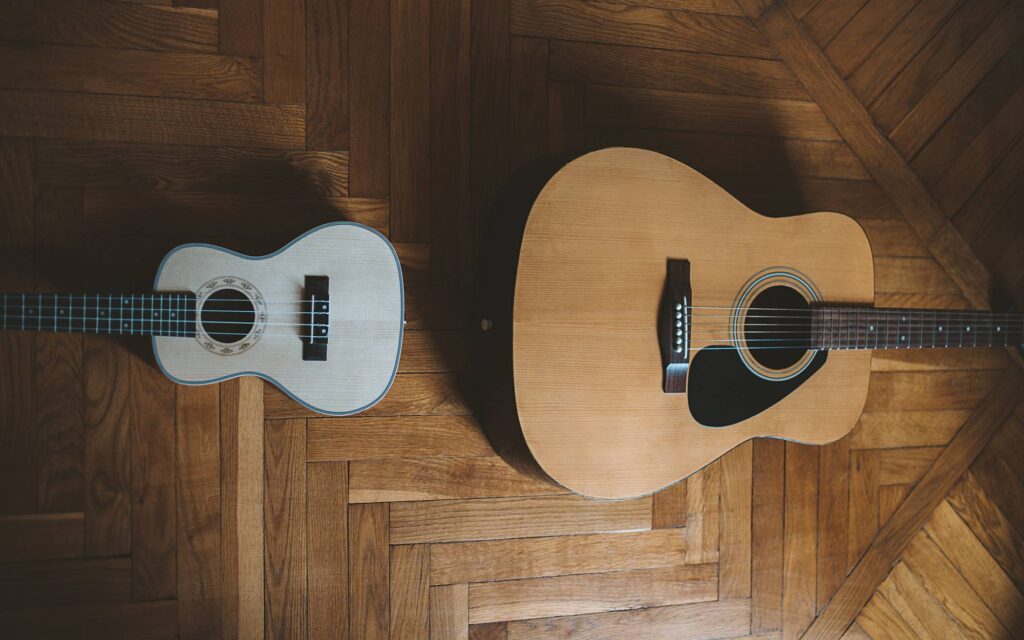
Yes, you can learn ukulele and guitar at the same time, but we wouldn’t recommend it for beginners. It’s better to focus on one instrument, gain some level of mastery at it, and then apply those skills to learning the other one. Learning both at once can be cumbersome and might make you lose interest in both if you’re not able to progress at a comfortable pace.







